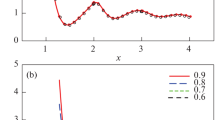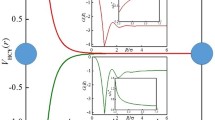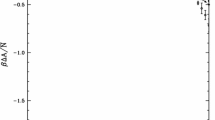Abstract
In this work, we derive analytical solutions for static structure factor for homogeneous and isotropic solution composed of two components interacting with each other via simple van der Waals potential which is inversely proportional to the sixth power of the distance between the two components. We assume that the first component is the solvent and the second component is the dissolved material which has low concentration or density in comparison to the concentration of the solvent, i.e. dilute solution, which is common for macromolecular fluids. The presented solution is obtained using direct and inverse Fourier transforms in solving Ornstein–Zernike equations (OZE) for multicomponent systems. We calculated isothermal compressibilities as a function of concentration and comparison with other simulation and theoretical results are presented. We believe that the presented solution can be useful in studying biomolecular fluids and other soft matter fluids.



Similar content being viewed by others
References
J P Hansen and I R McDonald, Theory of simple liquids third edn (Academic Press, 2005)
R Fantoni, Classical liquids: Exact results, integral equations theory and Monte Carlo simulations, Ph.D. thesis (Trieste, 2003)
G Nägele, The physics of colloidal soft matter (Institute of Fundamental Technological Research, Warsaw, 2004)
C N Likos, Effective interactions in soft condensed matter physics (DuKsseldorf, Germany, 2001)
A J Archer, Statistical mechanics of soft core fluid mixtures, Ph.D. thesis (University of Bristol, 2003)
E Matteoli and G A Mansoori, J. Chem. Phys. 4672 (1995)
W J Briels, Theory of polymer dynamics (Enschede, 1998)
C A Croxton, Liquid state physics: Statistical mechanical introduction (Cambridge University Press, 1973)
A M R de Graff and M F Thorpe, Acta Crystallogr. A 66, 22 (2010)
O M Osiele, Nigerian J. Phys. 18(1), 25 (2006)
G N Chuev and M V Fedorov, J. Chem. Phys. 120, 1191 (2004)
A Trokhymchuk et al, Condens. Matter Phys. 14(3), 33005 (2011)
J A Anta, F Bresme and S Lago, J. Phys. Condens. Matter 15, 1 (2003)
P Ziherl, Physics of soft matter (University of Ljubljana, Jožef Stefan Institute, Ljubljana, 2013)
B M Fine, A Lomakin, O O Ogun and G B Benedek, J. Chem. Phys. 104(1), 326 (1996)
P Vashishta, R K Kalia, J P Rino and I Ebbsjo, Phys. Rev. B 41, 12197 (1990)
Q Mei et al, Phys. Rev. B 78, 144204 (2008)
Author information
Authors and Affiliations
Corresponding author
Appendices
Appendix
Generalisation
We can generalise our calculation to higher concentrations and in this case we use eqs (12)–(15) to derive the following formulas:
and \(M_{\alpha \beta } (q_0 )\) are the same functions as in eqs (34)–(36).
Computational implementation
We have used Wolfram Mathematica online [18] resources to implement the computation using cloud computing. Users need to have registered software to be able to access these capabilities. To do so we did the following:
-
1.
We defined the needed parameters like \(\sigma _{11} \), \(\sigma _{22} \), \(D_{11} \) etc., calculate \(\beta \) for specific temperature to be used in \(S_{ij} \) and in M functions.
-
2.
We typed equations [31–33] for low densities and the general case equations as they appear in the Appendix, on Mathematica software. Note that only online Mathematica package will allow editing such long equations.
-
3.
Then we used online Wolfram Mathematica to calculate the results \(S_{ij} \) for every q (will take from half an hour to an hour).
Rights and permissions
About this article
Cite this article
Al-Raeei, M., El-Daher, M.S. Analytical static structure factor for a two-component system interacting via van der Waals potential. Pramana - J Phys 90, 60 (2018). https://doi.org/10.1007/s12043-018-1550-0
Received:
Revised:
Accepted:
Published:
DOI: https://doi.org/10.1007/s12043-018-1550-0
Keywords
- Ornstein–Zernike equation
- Van der Waals potential
- two-component fluid
- macromolecular fluid
- partial structure factor
- isothermal compressibility
- soft matter




